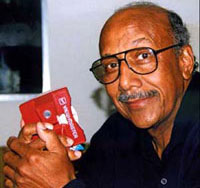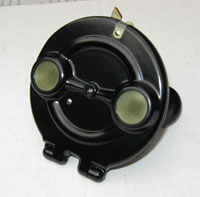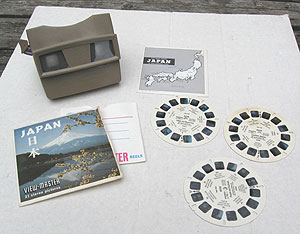I’m sure there are a lot of people who remember their View-Masters. Dropping the round flat reel of the Grand Canyon or Cinderella into the viewer’s slot, and clicking the little plastic lever to turn the reel and watch the story unfold.

I don’t have that memory. I didn’t grow up with a 3-D View-Master toy (a friend recalled having a red and white one). But I have come across several models at auction, and to be honest, I’ve been taken with them. I love vintage cameras, and looking through a viewer is the same experience as looking through a camera, except that someone else has done the work.
Some of the viewers I discovered were the early ones made of Bakelite. Others have been the familiar beige, and red and white ones made of plastic.

And the reels. I’ve come across tons of those: 1968 Dark Shadows, 1982 G.I. Joe, 1973 Disney on Parade, 1952 Hansel and Gretel, 1967 Road Runner, 1955 Snow White, 1956 A Christmas Carol and Indians of the Southwest.
With no history, I didn’t feel a personal connection to the View-Master itself. Until I was listening to a Little Known Black History Fact on the Tom Joyner Morning Show on radio a couple weeks ago while in my car. The segment was about a man named Charles Harrison, a longtime designer at Sears, Roebuck and Co. The commentator talked about how he had developed the large plastic trash can, improved on the sewing machine, hair dryer and other household products, and redesigned the View-Master in 1958.
 What? I perked up. I scrambled for a piece of paper and pen, and wrote down Harrison’s name.
What? I perked up. I scrambled for a piece of paper and pen, and wrote down Harrison’s name.
Once I got back home, I Googled him. Behold, he did exist and I had never heard of him.
Harrison began his industrial design career in the 1950s. He applied for a job at Sears in 1956 but was turned down because, he said in one interview, the company was not hiring blacks. He was picked up by a design firm in Chicago called Robert Podall Associates, where he helped to redesign the View-Master.
He said in a Smithsonian Magazine interview in 2008 that his job was to make the viewer cheaper, faster and more appealing. “It was low enough cost when I got done with it that they could buy it for children and let them play with it,” he said.
Sears hired him in 1961, and he eventually became its chief designer. He worked there for three decades before retiring in 1993, and helped design 700 products, most anonymously, which he said in an interview didn’t bother him. Today, Harrison is an adjunct professor in Art and Design at Columbia College in Chicago.
 In 2008, he received the Smithsonian’s Cooper-Hewitt, National Design Museum Lifetime Achievement Award. In 2005, he wrote his memoirs: “A Life’s Design: The Life and Work of Industrial Designer Charles Harrison.”
In 2008, he received the Smithsonian’s Cooper-Hewitt, National Design Museum Lifetime Achievement Award. In 2005, he wrote his memoirs: “A Life’s Design: The Life and Work of Industrial Designer Charles Harrison.”
I emailed Harrison at the college because I wanted to know for sure which View-Master model he redesigned. There are about a dozen models, and most stories did not identify his model. I’ve seen photos of him holding the beige and the red/white Model G. One site said his was the Model F, one I have not come across at auction. I haven’t gotten a reply from him yet.
The View-Master had been around long before Harrison took to it. It debuted at the New York World’s Fair in 1939, and was manufactured by the Sawyer Co. in Oregon. Many of the ones I came across have the Sawyer name on them.
From now on when I see a View-Master, I’ll remember Harrison’s contribution. What a find!

NOTE: Be sure to check out my story about an amazing black cinema collection in today’s Philadelphia Inquirer.
